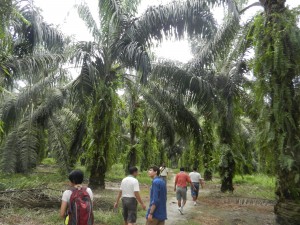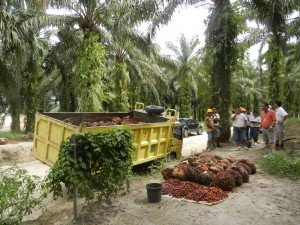Exploration of Roundtable on Sustainable Palm Oil Certification in Indonesia
This post was written by Ann Kuo, Nan Niljinda and Paul Winters from their research trip to Indonesia.
The flight from Jakarta to Pekanbaru in Sumatra’s Riau province is only about an hour and half, but the change in scenery is dramatic. The hustle and bustle of an emerging megacity of over 10 million people (and nearly as many motorbikes!) gives way to a small urban core amidst one of Indonesia’s major agro-industrial landscapes. Then, there’s another 3-4 hours of driving before you actually get to the palm plantation.
For three days, we were guests at an oil palm plantation in East Sumatra, the plantation is owned by a large vertically-integrated palm oil company. During our visit, the plantation’s staff walked us through the complete process of producing crude palm oil (CPO), from harvesting fresh fruit bunches (FFB) to crushing and refining the oil before it is shipped overseas to markets throughout Asia, Europe, and the United States. The plantation emphasized the points in the production process where sustainability practices were employed: for example, integrated pest management (IPM) decreased the amount of pesticide applied to the crops, a methane capture system resulted in a zero-waste production process–and smallholders from the local community enjoyed many of the same benefits of these best practices because the parent company had provided technical assistance and financial support to their local community partners.
To the representatives from this company, applying environmental and agricultural best practices, dealing fairly with the local community, and even sharing information with us as researchers (transparency) was second nature. But this experience is by no means assured if you choose to visit many, if not most, of the oil palm plantations in Indonesia or the rest of Southeast Asia, Africa, or South America. Palm oil expansion is a leading cause of deforestation in the tropics and prospects for boosting sustainability all too often are of secondary concern. The potential for profit is high and governments of developing countries consider palm oil expansion a significant opportunity to lift millions of people out of poverty.
Nevertheless, the visit to the oil palm plantation demonstrates that it is possible to move towards sustainability while maintaining economic viability. A voluntary certification scheme created by the Roundtable on Sustainable Palm Oil (RSPO) guides the company’s efforts to develop its product responsibly. Despite the initiative taken by a select group of companies, there are still vastly more non-certified than certified palm oil companies, and an active debate is ongoing amongst NGOs and between NGOs and businesses about which sustainability practices are necessary and how quickly industry members ought to adopt them into their production processes.
Our research team of Master’s students from the University of Michigan’s School of Natural Resources and Environment (SNRE) is in Indonesia this summer to investigate the sustainability of the oil palm industry. We are examining the opportunities and barriers to producer participation in certification, as well as the program’s additionality, that is, the progress towards implementing sustainable practices that could not have been achieved without the guidance and support of the RSPO and its set of Principles and Criteria. A case study of our work in Indonesia will be featured in a report about the conceptual linkages between the design and structure of certification programs and participation and additionality. A second team will be in Brazil later this summer to study the Sustainable Agriculture Network’s (SAN) certification for sustainable cattle production. The project is funded by a CGIAR Climate Change, Agriculture, and Food Security (CCAFS) grant to conduct research on the various systems governing the development of commodity agricultural products.
We are only halfway through conducting the interviews we have scheduled with stakeholders–including growers, manufacturers, sustainability consultants, third-party assessors, and social and environmental NGOs, but already a few important themes have emerged:
1. NGOs and producers use different indicators of success. For example, principle 8 of the RSPO certification requires companies to continuously improve on their sustainability commitments. Many of the NGOs we’ve spoken to interpret this requirement to mean that companies must continue to meet increasingly stringent targets for sustainability. Companies on the other hand, tend to view continuous improvement in a more open-ended way, periodically reviewing their progress from a baseline. This affects the rate of uptake of new sustainability practices.
2. Membership in the RSPO is a tool for recruiting new companies, serving as a step-ladder to certification. There is a distinction between certified and non-certified growers, but another level that is important to recognize is this intermediate group who are members, but not yet certified. Companies that become members join the multi-stakeholder conversation about how the industry can move towards greater sustainability. They learn from their peers about the successes and hurdles and they learn more about environmental and social issues through regular interactions with NGOs. While sustainability takes time, which is bought by this intermediary step, the concern from NGOs is that this step may also lead to a delay in efforts to become certified in a timely manner.
This week, we will visit another plantation in Sumatra as well as get the opportunity to meet with various stakeholders in Sanggau, West Kalimantan. These interviews and visits continue to provide us a picture of how the design of RSPO certification can and does affect the participation of growers.
Pictures from our adventures:

Being shown one of the baby barn owls in the field. Barn owls are used by plantations as integrated pest management (IPM) of the rats that consume the oil palm fruits.
News
IFRI Special Issue Collaboration
(17/09/2016)
FLARE Announces Keynote Speakers



